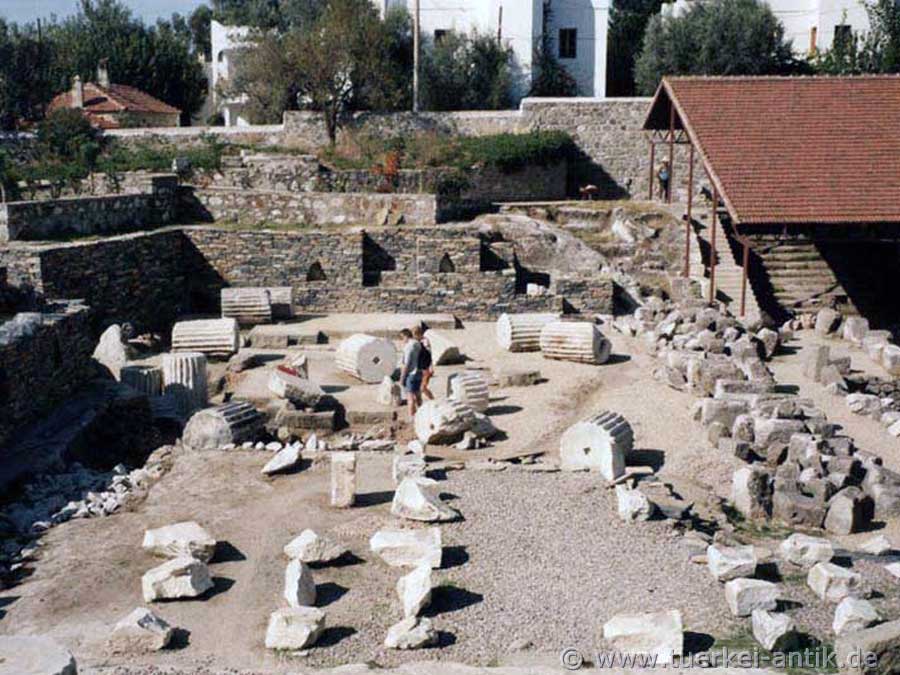 |
| Halicarnassus in Caria | |||
 |
|
||
| The Myndos Gate, one of the city gates | |||
|
It is probable that Halicarnassus - similar to Iasos and Miletus - was inhabited by Mycenaean Greeks as early as the 12th century BC. Near Halicarnassus a necropolis was discovered whose graves contained Mycenaean pottery. |
|||
|
|
|||
| The remains of the mausoleum of Halicarnassus | |||
|
Halicarnassus became famous in classical antiquity for the mausoleum of Halicarnassus, one of the classical Seven Wonders of the World. It was a tomb built for the Carian King Mausolus II. After him similar buildings were called "mausoleums". Maussolos made Halicarnassus the capital of his empire instead of the old Mylasa (today Milas). Next to a harbour, which was only accessible through a narrow channel, he had walls and watchtowers built to be secured both on land and at sea. A massive palace gave him a view in all directions. Maussolos, despite his Carian ancestry, had a great interest in Greek culture and, in addition to the city's military improvements, had a Greek theatre and a temple built for Ares.
After his death, his sister and wife Artemisia II took over Caria and Rhodes. She called the most famous Greek artists to Halicarnassus to decorate the magnificent tomb of Maussolos, the mausoleum of Halicarnassus.
The mausoleum was probably destroyed by an earthquake in the 14th century; remains of the building are used in St. Peter's Castle. Some of the sculptures were brought to the British Museum in London. |
|||
|
|
|||
| The Castle of St. Peter | |||
|
St. Peter's Castle, built in 1420 by Crusaders, fell into the hands of the Ottomans without a fight in 1523 when the Knights of St. John abandoned Rhodes. The Ottomans used it as a place for exile until the 20th century. The castle is almost completely preserved and can compete with the most magnificent knight's castles in Europe such as Chillon or Château-Gaillard, its weirs and towers are partly of Franconian and partly Byzantine origin. Even today it still houses rich figurative jewellery from various epochs. In the castle there is an underwater museum worth seeing. The showpiece is the ship of Uluburun, a wreck from the Bronze Age, which was lifted together with its cargo and equipment. There is much speculation about the origin of the ship, since objects from Mycenaean Greece, Cyprus, Canaan, Persia, Egypt and Assyria were found in the wreck and the personal belongings of the crew also came from many countries. Perhaps a large part of the cargo was destined for a Mycenaean palace, but it may also be that merchants were on board, one of whom used that wooden blackboard, which was also preserved. |
|||
|
|
|||
| The Theatre | |||
|
The Hellenistic theatre was built, as archaeologists disagree, either in the 1st half of the 3rd century BC or in the late 2nd century BC. The lower part of the cavea was completely cut out of the rock. The stage building was rebuilt in the Roman imperial period.
Restoration work in 1976 and 1985 was stopped after a short time due to a lack of financial resources. It was not until 2000, under the direction of the Bodrum Museum of Underwater Archaeology and with the help of sponsorship from the telecommunications companies Turkcell and Ericsson, that the theatre began to be renovated. The work was completed at the end of June 2003 and the theatre was opened to the public. |
|||
|
|
|||
|
|
|||
| The diazoma completely cut into the rocks | |||
|
|
|||
|
In 334 B.C. Halicarnassus was the last fortress of the Persians against the conquest of Alexander the Great in Asia Minor. Memnon of Rhodes expanded the city and port as the operational base of the Persian fleet.
By a decree of the Great King Darius III, he was in the meantime supreme commander. Alexander had siege towers and wall breakers used against the city.
From about 280 BC to 200 BC Halicarnassus belonged to the Ptolemaic Empire. The expansion of the Seleucids and the subjugation of the Greek cities of Asia Minor brought Rome onto the scene.
Since 129 B.C. Halicarnassus belonged to the Roman province of Asia. |
|||
|
|
|||
|
|
|||
| Photos: @chim, Monika P. | |||
| Translation aid: www.DeepL.com/Translator | |||
| Source: Wikipedia and others | |||
|
|
|||


